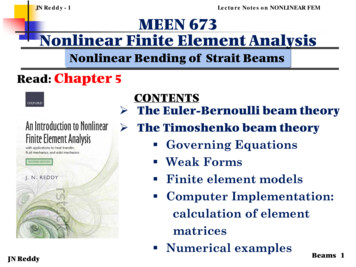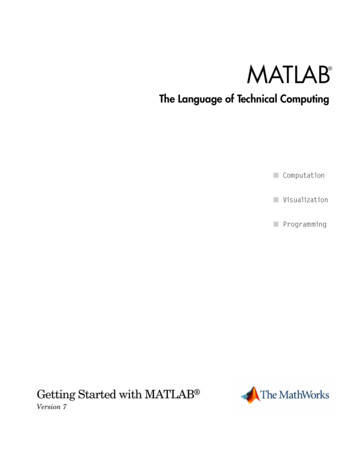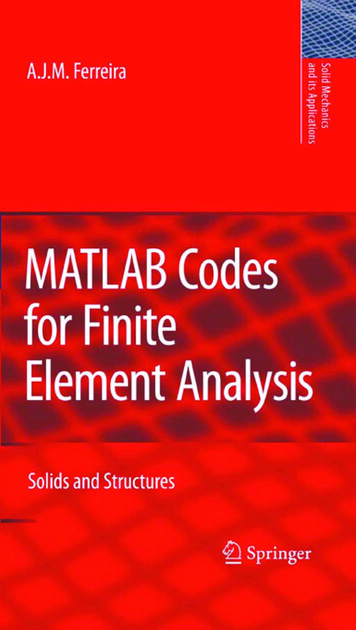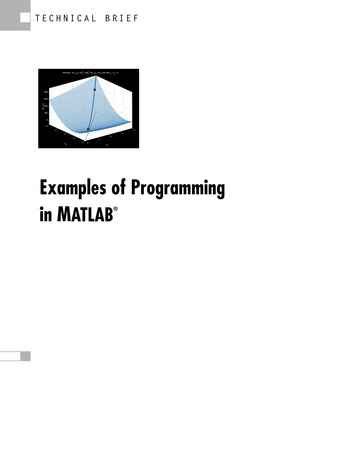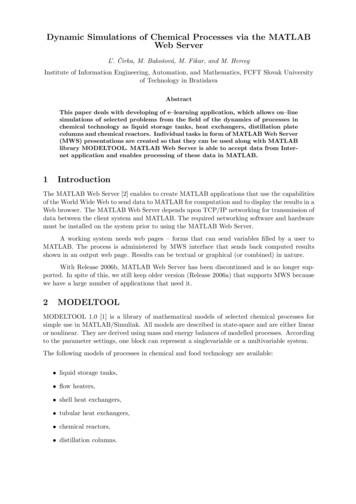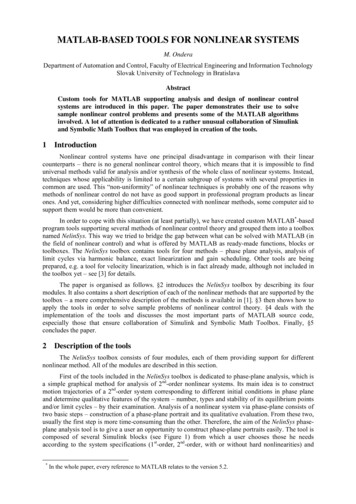
Transcription
MATLAB-BASED TOOLS FOR NONLINEAR SYSTEMSM. OnderaDepartment of Automation and Control, Faculty of Electrical Engineering and Information TechnologySlovak University of Technology in BratislavaAbstractCustom tools for MATLAB supporting analysis and design of nonlinear controlsystems are introduced in this paper. The paper demonstrates their use to solvesample nonlinear control problems and presents some of the MATLAB algorithmsinvolved. A lot of attention is dedicated to a rather unusual collaboration of Simulinkand Symbolic Math Toolbox that was employed in creation of the tools.1IntroductionNonlinear control systems have one principal disadvantage in comparison with their linearcounterparts – there is no general nonlinear control theory, which means that it is impossible to finduniversal methods valid for analysis and/or synthesis of the whole class of nonlinear systems. Instead,techniques whose applicability is limited to a certain subgroup of systems with several properties incommon are used. This “non-uniformity” of nonlinear techniques is probably one of the reasons whymethods of nonlinear control do not have as good support in professional program products as linearones. And yet, considering higher difficulties connected with nonlinear methods, some computer aid tosupport them would be more than convenient.In order to cope with this situation (at least partially), we have created custom MATLAB*-basedprogram tools supporting several methods of nonlinear control theory and grouped them into a toolboxnamed NelinSys. This way we tried to bridge the gap between what can be solved with MATLAB (inthe field of nonlinear control) and what is offered by MATLAB as ready-made functions, blocks ortoolboxes. The NelinSys toolbox contains tools for four methods – phase plane analysis, analysis oflimit cycles via harmonic balance, exact linearization and gain scheduling. Other tools are beingprepared, e.g. a tool for velocity linearization, which is in fact already made, although not included inthe toolbox yet – see [3] for details.The paper is organised as follows. §2 introduces the NelinSys toolbox by describing its fourmodules. It also contains a short description of each of the nonlinear methods that are supported by thetoolbox – a more comprehensive description of the methods is available in [1]. §3 then shows how toapply the tools in order to solve sample problems of nonlinear control theory. §4 deals with theimplementation of the tools and discusses the most important parts of MATLAB source code,especially those that ensure collaboration of Simulink and Symbolic Math Toolbox. Finally, §5concludes the paper.2Description of the toolsThe NelinSys toolbox consists of four modules, each of them providing support for differentnonlinear method. All of the modules are described in this section.First of the tools included in the NelinSys toolbox is dedicated to phase-plane analysis, which isa simple graphical method for analysis of 2nd-order nonlinear systems. Its main idea is to constructmotion trajectories of a 2nd-order system corresponding to different initial conditions in phase planeand determine qualitative features of the system – number, types and stability of its equilibrium pointsand/or limit cycles – by their examination. Analysis of a nonlinear system via phase-plane consists oftwo basic steps – construction of a phase-plane portrait and its qualitative evaluation. From these two,usually the first step is more time-consuming than the other. Therefore, the aim of the NelinSys phaseplane analysis tool is to give a user an opportunity to construct phase-plane portraits easily. The tool iscomposed of several Simulink blocks (see Figure 1) from which a user chooses those he needsaccording to the system specifications (1st-order, 2nd-order, with or without hard nonlinearities) and*In the whole paper, every reference to MATLAB relates to the version 5.2.
interconnects them into a simulation scheme – in the simplest case the scheme involves only twoblocks, one for calculation of a numerical solution of the system and the other for graphical plot of thephase-plane portrait. Another advantage of using Simulink for obtaining phase-plane portraits is thatwhile the simulation is running, user can observe how the portrait is being generated and get additionalinformation about the nonlinear system this way.Figure 1: The NelinSys toolbox – Phase-Plane Analysis blocksetThe second tool from the NelinSys toolbox is devoted to limit cycle analysis based on harmonicbalance or, more precisely, to a so-called two-characteristics method. The method is suitable foranalysis of nonlinear control loops consisting of a high-order linear part and an isolated staticnonlinearity (Figure 2). There are two basic principles that the method takes advantage of: first, if thelinear part of the system works as a low-pass filter, then (for calculation purposes) the nonlinearity canbe substituted by a so-called describing function – see [1] or [4] for further details – and second, ifthere exist a limit cycle in the system, then its approximate amplitude a and approximate frequency ωcan be determined by a solution of the harmonic balance equationFL (iω ) 1Fe (a )(1)where FL(iω) stands for the frequency transfer function of the linear part and Fe(a) for the describingfunction of the nonlinearity. Equation (1) can be solved either analytically, or graphically. In the lattercase, which is sometimes referred to as the Two-Characteristics Method, two parametric curves areplotted in the complex plane, one that corresponds to the Nyquist plot of the linear part FL(iω) and theother to the graphical plot of the right-hand side of the equation (1) i.e. to the term -1/Fe(a). If the twocurves have an intersection, then a limit cycle exists in the system and its quantitative parameters arethe values of a and ω corresponding to the intersection. In case of more intersections, there are morelimit cycles with different amplitudes and/or frequencies.0e –GNIsolated nonlinearityuFLyHigh-order linear partFigure 2: Nonlinear system suitable for harmonic-balance analysis of limit cyclesThe Two-Characteristics Method tool included in the NelinSys toolbox gives a hand with the decisionif there exists a limit cycle in a user-specified nonlinear system (of the Figure 2 structure) by plotting
the two curves in the complex plane (amplitude and frequency ranges are defined by user). Moreover,besides GUI version of the tool (Figure 3) there is also a text-based version, which is able to calculatethe parameters of the limit cycle(s) analytically as well, by employing Symbolic Math Toolbox. Thetool supports four types of nonlinearities so far – ideal relay, relay with dead-zone, relay withhysteresis and saturation.Figure 3: The NelinSys toolbox – Two-Characteristics Method tool (GUI version)Next of the NelinSys tools deals with exact linearization. The objective of the method is tocontrol a nonlinear system given in the formx& f ( x) g ( x)u(2)y h( x)by turning it into a linear and controllable one i.e. such that can be described by linear state-spaceequationsq& Aq Bv(3)y Cqwith a help of nonlinear state-space transformation q q(x) and nonlinear state feedback u u(x,v).Once this is done, we can design a stabilizing linear controller for the linearized input v using arbitrarysuitable linear control design method, e.g. pole placement. If (2) is a controllable SISO system, thenthe objective of the method can be met by applying nonlinear transformation h( x ) L f h( x ) .q q( x) r 2 L f h( x ) r 1 L f h( x ) (4)and nonlinear state feedbacku 1Lg L fr 1( Lh( x)rfh( x ) v)(5)
The L is a so-called Lie derivative operator defined asnL f h( x ) i 1 h( x)f i ( x) xi(6)and r is the relative degree of the system; it has to be equal to the system order n for the transformation(4) to be complete. A more detailed description of exact linearization can be found in [1] or [4].Figure 4: The NelinSys toolbox – Exact linearization controller design tool (SISO GUI version)Figure 5: The NelinSys toolbox – Exact linearization blockset for SimulinkThe NelinSys exact linearization module is composed of two submodules, one dedicated tocalculation of a linearizing controller (Figure 4) and the other to performance evaluation of thusdesigned control loop (Figure 5). The use of the tool is very easy – to a user-specified nonlinearsystem (2) it calculates necessary transformations (4) and (5), puts them as parameters intocorresponding Simulink blocks, creates a ready-to-run Simulink simulation model supplemented with
a linear pole placement controller and lets the user judge the performance of the loop. Besides SISOsystems, the NelinSys toolbox can also handle exact linearization of MIMO systems with the samenumber of inputs and outputs.The last of the NelinSys modules provides support for gain scheduling. The basic idea of gainscheduled control of a nonlinear system is to design multiple linear controllers (instead of designing asingle nonlinear one) based on different operating points and to switch between them according tocurrent operating point. This idea can be further extended by parameterization of the controllers,which practically turns switching into continuous adjustments of controller parameters. A moredetailed description of the method together with some consequences and recommendations can befound in [1]. In the following, design of a gain scheduled state-space controller (also called extendedlinearization) will be considered. The method assumes a nonlinear system given by nonlinear statespace equationsx& f ( x, u )(7)y h( x )If (x0, u0) is an equilibrium point of the system, then by a Taylor expansion of the nonlinear functions fand h and by neglecting higher-order terms one can get a linear approximation of the system dynamics x& A0 x B0 uwhere x x – x0, u u – u0, y y – y0(8) y C 0 xAs this approximation is valid only in a close neighbourhood of the equilibrium point, so is the controldesign based upon it. And here come the ideas of gain scheduling – let us design different controllersfor different equilibrium points and switch between them or, better than that, let us design a controllerwhose parameters will change according to current operating point continuously. In order to do that,first we have to describe equilibrium points (x0, u0) of the system (7) with as few independentparameters as possible. These parameters, so-called scheduling variables, are chosen so that they areequal to one or more measurable system variables, e.g. the desired value w, the system output y or thecontrol action u. The reason for that is obvious – once the controller is implemented, schedulingparameters are replaced with actual measured values. In SISO case, one parameter is usually enoughto describe the equilibrium points. If we denote the parameter as α then (8) can be rewritten asd[x x0 (α )] A0 (α ) [x x0 (α )] B 0 (α ) [u u0 (α )]dty y 0 (α ) C 0 (α ) [x x0 (α )](9)A state-space controller designed to control this system can be described by the equationu u(w, x) u0(α) k0(α) [w – w0(α)] – K(α) [x – x0(α)](10)Feedback part of the control law K(α) can be computed via pole placement fromndet[sI ( A0 (α ) B0 (α ) K (α ) )] (s pi )(11)1 1C0 (α )[A0 (α ) B0 (α ) K (α )] B0 (α )(12)i 1and feedforward part ask 0 (α ) This will assure that the closed loop system will have desired poles pi, i 1, 2, ., n, for arbitrary α i.e.for any of its equilibrium points.Similarly as the NelinSys exact linearization module, the gain-scheduling tool also incorporatestwo parts – a controller design part (Figure 6) and a simulation part. While the first one lets a usercalculate a gain scheduled controller based on state-space equations of a nonlinear system, desiredpoles of the closed loop and desired scheduling variable, the other serves as a verification tool and letshim decide if and how the control design satisfies desired performance criteria by means of Simulinksimulation. And again, the use of the tool is very simple, leaving no unnecessary calculation to theuser.
Figure 6: The NelinSys toolbox – Gain-scheduling controller design tool (SISO GUI version)3Application of the toolsThis section contains two examples demonstrating application of the NelinSys tools to solutionof sample problems of nonlinear analysis and nonlinear control design.Example 1Let us consider a nonlinear system with the structure according to Figure 2, where the transferfunction of the linear part is2(13)FL ( s ) 2s 0,5sand the nonlinearity GN is a relay with hysteresis with gain K 2 and hysteresis width B 0,5. Thetask is to find whether there exists a limit cycle in the system and if so to determine its parameters.Figure 7: Analysis of limit cycles with a help of Two-Characteristics method
Since the nonlinear system is of required type, we can use the Two-Characteristics-method toolto solve the problem. If we provide the tool with input data, we obtain the plot (Figure 7) from whichit is possible to conclude that there is one limit cycle in the system – the two curves have oneintersection. Approximate parameters of this limit cycle – its amplitude a 1,7 and frequency ω 1,7– can be determined analytically by a solution of the harmonic balance equation (1). In most cases,they can be calculated with a help of the text-based version of the tool that incorporates SymbolicMath Toolbox as a solver. However, there are also cases in which Symbolic Math Toolbox fails tofind an explicit analytical solution of (1) so it has to be calculated manually.As (13) is a 2nd-order linear system and relay with hysteresis is a static nonlinearity, we canalternatively analyze the same system using NelinSys Phase-Plane Analysis tool. This analysis is veryeasy, because all we need to do is just to build a simulation (Figure 8) from the blocks included in theNelinSys toolbox (Figure 1) and standard Simulink Scope block, specify parameters of the blocks andrun it. During the simulation we can observe how the phase-plane portrait (Figure 9) is beinggenerated and afterwards we can accordingly judge the limit cycles.Figure 8: Analysis of limit cycles in phase plane – simulation scheme for SimulinkFigure 9: Analysis of limit cycles in phase plane – phase-plane portrait of the systemUtilizing knowledge from phase-plane analysis theory and the simulation result in Figure 9, wecome to the same conclusion as before – there is one limit cycle in the system because there is oneisolated closed path in the phase-plane plot. Moreover, we can add that the limit cycle is stablebecause all neighbouring system trajectories converge to the closed path. The quantitative parametersof the limit cycle can be determined by exploring the time-plot in Figure 10 – the amplitude ofsustained oscillations is approximately a 1,716 and the period is T 3,8s, which corresponds to thefrequency ω 1,653.
Figure 10: Analysis of limit cycles in phase plane – time responseExample 2The task is to design a nonlinear controller to a Two-tanks without interaction system describedby nonlinear state-space equations x&1 x1 x& 2 x1 x 2y x2 1 u 0 (14)Since (14) suits both the system description required by exact linearization (2) and by gainscheduling (7), we can use either of the methods. Let us choose exact linearization first and let usemploy NelinSys exact linearization module (Note: for better readability of the program output,text-based version of the controller design tool is used in the following example, user input is writtenin italics).Exact linearization for SISO pace equations: x f(x) g(x) uy h(x)System order: 2System matrix: f(x) [-sqrt(x1); sqrt(x1)-sqrt(x2)]Input matrix: g(x) [1; 0]Output matrix: h(x) x2Controllability: system is controllable if the following expression is nonzero:1- 1/2 ----1/2x1Transformation equations:q1 x2q2 x1 (1/2)-x2 (1/2)Relative degree of the system: 2Nonlinear feedback: u x11/2----- 2 x1v1/2x2This way we have calculated the state-space transformation (4) and the linearizing control law (5)necessary to turn the nonlinear system (14) into the form q&1 0 1 q1 0 v q& 2 0 0 q 2 1 q y (1 0) 1 q2 (15)
i.e. to a linear and controllable form. In order to complete the controller synthesis, we need to design alinear controller for (15). The linear controller can be designed using arbitrary linear technique,however, if pole placement is chosen, special blocks from the NelinSys exact linearization blockset(Figure 5) can be utilized and performance-evaluating simulation can be started immediately.Simulink scheme used for the simulation is in Figure 11, simulation result in Figure 12.Figure 11: Exact linearization – simulation scheme for SimulinkFigure 12: Exact linearization – simulation resultsNow let us try gain scheduling and the NelinSys gain-scheduling module. Again, in order toimprove the readability of the output, the use of the text-based version of the controller design toolwill be illustrated instead of the GUI version.Gain Scheduling control for SISO linear system: (1) x f(x,u)y h(x,u).(2) x f(x) g(x) uy h(x)Choose one of the options: 2System order: 2System matrix function: f(x) [-sqrt(x1); sqrt(x1)-sqrt(x2)]Input matrix function: g(x) [1; 0]Output matrix function: h(x) x2.System linearization: / x A / x B / u/ y C / x D / u
A [1[- 1/2 ----[1/2[x1[[1[ 1/2 ----[1/2[x1]]]]]1 ]- 1/2 -----]1/2]x2]0B [1][ ][0]C [01]D 0System equilibrium points: u x2 (1/2), x1 x2Desired poles of the closed-loop system: [-2 -2]Controller for the system linearization: / u f0 / w - K / xf0 1/28 x2K [111/2][- ----- 41/2 ----- - 4 8 x2][1/21/2][ x2x2]Gain Scheduling type: (1)(2)(3)(4)Selected scheduling type:no scheduling (fixed operating point)input scheduling (w)output scheduling (y)mixed scheduling (m*w (1-m)*y)2Control action: u 1/21/23/2(-w 4 w) x1(-w 8 w - 16 w) (x2 - w)- ---------------- 4 w 1/2 -------------------------------wwAfter we are ready with the calculation of the control law, we can evaluate performance of the closedloop system by means of a Simulink simulation. The scheme, composed of blocks from the NelinSysgain-scheduling blockset, is in Figure 13, simulation results in Figure 14. Although in the exampleabove input scheduling was considered, with a different scheduling variable the control law would bedifferent as well. Therefore, Figure 14 demonstrates two cases – the green line corresponds to inputtype whereas the red line to output-type scheduling; the blue line is the desired value w.Figure 13: Gain scheduling – simulation scheme for Simulink
Figure 14: Gain scheduling – simulation results4Implementation detailsThe NelinSys toolbox was designed with the intention to be a user-friendly and intuitive“plug-in” for MATLAB – or rather for Simulink (in fact, the toolbox is encapsulated as a Simulinklibrary, although it contains links to pure-MATLAB applications). Therefore, from users’ point ofview it behaves just like any other Simulink blockset and anybody who wants to use it needs nofurther knowledge than basic MATLAB/Simulink navigation and, of course, at least a basic level ofnonlinear control theory. However, NelinSys can be also interesting from developers’ point of view,because its MATLAB implementation involves a few unusual features; some of them will bediscussed in this section.Probably the most important feature is the collaboration of Simulink and Symbolic MathToolbox. The need for this collaboration results from the fact that all NelinSys’ modules (perhapsexcept for the Two-Characteristics Method tool) require both symbolic and numerical calculations.Exact linearization for instance – in the control design process, large amount of symbolic computationis used (e.g. calculation of analytical partial derivations of functions, algebraic operations withfunctional matrices, etc.) whereas consequential simulation of the closed-loop system is a numericaltask. Thanks to Simulink Symbolic Math Toolbox collaboration it is possible to use the control lawin simulation in symbolic form. That means a lot because without the collaboration, after calculationof the control law a user would need to create a simulation scheme manually by converting the controllaw from the symbolic form to a chain of standard Simulink blocks (of course, this would also meanthe necessity to modify the scheme each time the system description of the original nonlinear system ischanged).So far, Simulink is completely numerical i.e. there is not a single block able to work withsymbolic variables. Nevertheless, since it contains user-definable blocks such as MATLAB Fcn andS-function, symbolic capabilities can be incorporated into Simulink by a developer. This was done as apart of implementation of NelinSys. Besides S-function blocks, there were two other services utilizedin making Simulink understand symbolic data – the Subsystem block from standard Simulink // Connections library and the Mask Subsystem item from Simulink’s Edit menu. S-functions allowa developer to create custom Simulink blocks whose behaviour is determined by a program codeconsisting of arbitrary MATLAB commands (i.e. including commands from Symbolic Math Toolbox).Mask Subsystem, on the other hand, helps to create a user-friendly interface between S-function codeand simulation scheme, processes user-specified input parameters and transforms them into the formrequired by the S-function. The transformation is carried out via block initialisation commands that canagain take advantage of Symbolic Math Toolbox. Although symbolic expressions cannot be used asblock parameters, string expressions can, which means that with a help of sym-string conversioncommands char and sym symbolic values can be specified to the blocks.The principle described in previous paragraph was more or less used in programming of almostevery Simulink block contained in the NelinSys toolbox. In the following, the Nonlinear SISO system
(State-Space model) block’s implementation is analyzed as a representative example. Internal structureof the block is depicted in Figure 15 and its parameters setup in Figure 16.Figure 15: Internal structure of the Nonlinear SISO system (State-Space model) blockFigure 16: Parameters set-up screen of the Nonlinear SISO system (State-Space model) blockUser has to specify three things – system order, system matrix-functions f(x), g(x), h(x) and initialconditions. While there are no problems with the first and the third one (they are numerical entries),the matrix functions have to be treated in a different way – the block’s mask treats them as strings,block initialization commands transform them and pass them to the S-function, which finally workswith them as with symbolic objects. As can be seen in Figure 16, each of the matrix functions can bespecified either as a symbolic expression or as an identifier of a symbolic variable. The latter allowsthe block to use variables from MATLAB workspace – typically those that were put there by acontroller design tool (Figure 4, Figure 6) – so that a simulation can be started immediately after thecontrol law is calculated, while the former is usually used when a stand-alone simulation is needed. Itis also possible to combine the two options, e.g. f(x), g(x) can be specified as a symbolic expressionand h(x) as an identifier, however, this is hardly ever necessary.The initialization commands of the block (see the code listed below) first check which of thetwo representations for f(x), g(x) and h(x) (symbolic expression or identifier) is to be used, search theexpressions for unknown symbols (the execution is stopped if there are any), check if matrixdimensions are appropriate according to system order and, finally, adjust the parameters to the formconvenient for the S-function.
% Overenie spravnosti zadania parametrov bloku %if isempty(F) & (Fp 0)F sym(F);elseif isempty(F) & (any(Fp 0))F sym(Fp);elseerror(['Matrix f(x) unspecified or specified more than once - cannotcontinue!']);endif isempty(G) & (Gp 0)G sym(G);elseif isempty(G) & (any(Gp 0))G sym(Gp);elseerror(['Matrix g(x) unspecified or specified more than once - cannotcontinue!']);endif isempty(H) & (Hp 0)H sym(H);elseif isempty(H) & (any(Hp 0))H sym(Hp);elseerror(['Matrix h(x) unspecified or specified more than once - cannotcontinue!']);end% ZistipremF premG premH si symbolicke premenne, ktore vystupuju vo vyrazoch %strrep(strrep(findsym(sym(F)),', ',''),',',' ');strrep(strrep(findsym(sym(G)),', ',''),',',' ');strrep(strrep(findsym(sym(H)),', ',''),',',' ');% Premenne x1, x2, ., xN su korektne, preskoc ich %for k 1 : npremF strrep(premF, sprintf('x%d',k), '');premG strrep(premG, sprintf('x%d',k), '');premH strrep(premH, sprintf('x%d',k), '');end% Ak niektory retazec nezostal prazdny, vyhlasif isempty(premF)error(['Unknown symbol in f(x) expression endif isempty(premG)error(['Unknown symbol in g(x) expression endif isempty(premH)error(['Unknown symbol in h(x) expression endchybu %cannot continue!']);cannot continue!']);cannot continue!']);% Otestovanie spravnosti rozmerov matic F,G,H (podla "n") %if prod(size(F) [n,1])error(['Invalid matrix dimensions: f(x) - cannot continue!']);endif prod(size(G) [n,1])error(['Invalid matrix dimensions: g(x) - cannot continue!']);endif prod(size(H) [1,1])error(['Invalid matrix dimensions: h(x) - cannot continue!']);end% Kontrola vektora pociatocnych podmienok (pociatocnych stavov) %if prod(size(pp) [n,1])error(['Invalid dimensions: initial conditions vector - cannotcontinue!']);end% Nahradenie identifikátorov "xI" identifikátormi "x(I)" %for k 1 : nF subs(F, sprintf('x%d',k), sprintf('x(%d)',k));
G subs(G, sprintf('x%d',k), sprintf('x(%d)',k));H subs(H, sprintf('x%d',k), sprintf('x(%d)',k));endThe code of the stavp siso S-function (see below) implements the behaviour of the nonlinearSISO system specified by the block parameters. There are n continuous states (where n is the systemorder), one input and n 1 outputs – besides the output y of the nonlinear system itself, the block alsooutputs the whole state-space vector x. In every time instant a calculation according to system statespace equations is performed. As the equations are nonlinear and, therefore, their result might notremain in real domain for some values of system states and/or inputs, it is also checked whether theresult is real (if not, an error message is generated).function [sys,x0,str,ts] stavp siso(t,x,u,flag,n,F,G,H,pp)switch flag,% Inicializacna cast s-funkciecase 0 %% Definicia stavov, vstupov a vystupov nelinearneho systemu %sizes simsizes;sizes.NumContStates n;sizes.NumDiscStates 0;sizes.NumOutputs 1 n;sizes.NumInputs 1;sizes.DirFeedthrough 0;sizes.NumSampleTimes 1;sys simsizes(sizes);% Inicializacia pociatocnych podmienok %x0 pp;% Inicializacia "str" ako prazdna matica %str [];% Sample times in TS %ts [0 0];% Vypocet podla 1. stavovej rovnice %case 1sys eval(F) eval(G) * u;for k 1 : nif isreal(sys(k,:))error(['At the time instant t ',num2str(t),'s, the mathematicalmodel of the system is no longer valid! Cannot continue thesimulation!']);endend% Vypocet podla 2. stavovej rovnice %case 3sys(1,:) eval(H); % Ako vystup bloku sa berie nielen vystup systemu. %sys(2:n 1,:) x;% . ale aj cely stavovy vektor nelinearneho systemu %% Nepouzite priznaky %case {2, 4, 9}sys [];% Spracovanie chyby %otherwiseerror(['Unknown flag ',num2str(flag)]);endBesides the need for collaboration of Simulink and Symbolic Math Toolbox, which was thebiggest challenge resulting from creation of the NelinSys toolbox, there were also other minorproblems to cope with during programming. One of them was the necessity to use different sets ofinitial conditions for calculation of different phase-plane trajectories (Phase-Plane Analysis tool).
However, according to S-function template, for an nth-order system it is possible to define only ninitial conditions i.e. only one vector of the length n, which would mean that during one simulation itis possible to calculate (and to plot) only one phase-plane trajectory. This would be a greatdisadvantage because it would be almost impossible to read qualitative features of a system from onlyone trajectory. Of course, there would be a possibility to draw several trajectories one after another,but that way we would lose the synchronization i.e. the advantage of seeing how the phase-planeportrait is being gradually generated (after all, we would have only a static picture). Therefore, forNelinSys we used another approach: pretending a higher-order system to an S-function. For example,if we need to have a phase-plane portrait of a 2nd-order system containing 5 trajectories, instead of5 different pairs of initial conditions we will specify to the S-function a 10th-order system with onlyone initial condition vector composed of 10 elements (obviously, the 10th-order system will consist ofequations of the original 2nd-order system repeated in pairs). The approach can be illustrated by asource code of any of the phase-plane analysis blocks’ S-functions (for the sake of brevity the code isomitted here, but it can be located in the NelinSys folder; see e.g. the fazrov auton2.m file).5ConclusionIn this paper NelinSys – a custom toolbox for nonlinear control systems – was introduced. It wasshown how to u
sample nonlinear control problems and presents some of the MATLAB algorithms involved. A lot of attention is dedicated to a rather unusual collaboration of Simulink and Symbolic Math Toolbox that was employed in creation of the tools. 1 Introduction Nonlinear control systems have one principal disadvantage in comparison with their linear


